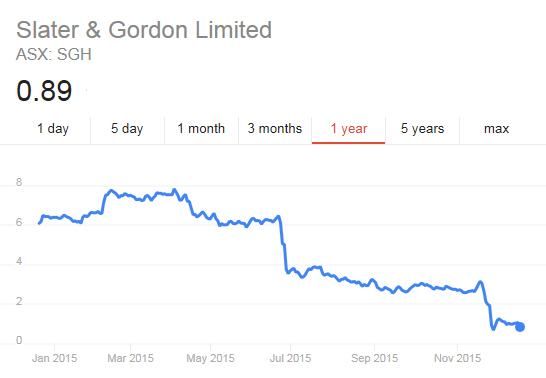When a share market has a poor year diversified investors generally have their pain quarantined for various reasons. Investors holding share funds aren’t likely to have their holdings limited to one share market. They’re also not likely to be holding only share based investments. Any portfolio worth its salt would include fixed interest, listed real estate and cash.
With global share markets offering differing returns and the various asset classes doing the same, a 5% decline on the ASX this year shouldn’t be an issue for the diversified investor.
For the DIY hot share tip merchant, trying to pick the best times to enter and exit shares, well that’s another story because amongst that overall decline of 5% there are plenty of companies that did much worse.
Law firm and injury compensation specialist, Slater & Gordon have had a torrid year on the ASX. They kicked off 2015 at $6.40 a share, before reaching a high of $8.07 in April. A week earlier in March, they had struck a deal to acquire the professional services division of UK insurance claims processor Quindell.
Some said the $1.3 billion acquisition was paying over the odds, and at a time when the UK government was cracking down on ‘ambulance chasing’ compensation claims.
From the point of the acquisition of Quindell, Slater & Gordon shares had been riding the escalator down, before hopping on a downward elevator in June, dropping to $3.56 when questions were raised about the reliability of Quindell’s financials.
The next hit came in November when Slater & Gordon’s earnings guidance came into focus. Few believe they’ll make their targets and management warned of cash flow going negative. The reaction pummelled the share price to an intra-day low of 69 cents.

The share rout was enough to prompt a front page headline of “$1.3B FOOLS” from Melbourne’s Herald Sun, where it dredged up the old chestnut of “angry mum-and-dad investors” who lost heaps. It also included some personal stories of scorched AFL footballers, retirees and warehouse workers, none of whom should have been putting their money anywhere near individual shares.
Their stories could be featured in a “what not to do when investing” checklist. Geelong footballer Mark Blicavs bought his $55,000 worth of Slater & Gordon shares in June at $3.56 after their first major fall.
The timing would suggest Mr Blicavs was on a bottom fishing exercise – he jumped in right after the plunge in June when Quindell’s financials were under scrutiny. Something many ‘investors’ do after a company has had a major price fall. The reasoning suggests the fall has been an overreaction and the buyer is getting in at the ground floor, set for the next movement up.
This can be a good strategy for the wider market because there are hundreds of businesses in various industries and sectors comprising an index, so risk is lessened and growth often emerges. When it comes to a single company, a fall often indicates significant issues at that company and there may well be other nasties around the corner.
Something Mr Blicavs found out when 5 months later he’d lost more than 80% of his investment. Blicavs’ teammate Jed Bews also purchased Slater & Gordon shares a month later in July at “about $4” – after talking to Blicavs about it. As you’d imagine, chatting to a mate isn’t the most robust investment strategy.
The range of returns from other asset classes from July to November, when the pair had watched their investment plunge over 80%, were 4.52% for Global Shares to -2.12% for Australian shares, with fixed interest, cash and listed property somewhere in between.
Had they stuck to a boring, diversified portfolio comprising the various asset classes, Blicavs and Bews likely would have seen a slightly positive return on their money and wouldn’t now be crossing their fingers that Slater and Gordon hits a very unlikely full year profit figure.
But as Mr Bews said, “I guess that’s the risk you take.”
This represents general information only. Before making any financial or investment decisions, we recommend you consult a financial planner to take into account your personal investment objectives, financial situation and individual needs.




